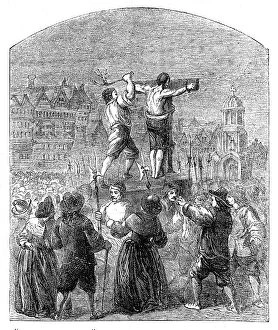Pillory Collection (#3)
The pillory, a symbol of social punishment and public humiliation, has played a significant role throughout history
All Professionally Made to Order for Quick Shipping
The pillory, a symbol of social punishment and public humiliation, has played a significant role throughout history. From the infamous Charing X Pillory in London to the engraving depicting Daniel Defoe's time in the pilory, this form of punishment was used to shame individuals who went against societal norms. In America, during the Stamp Act era, burning the stamps became an act of defiance against British rule. The pillory served as a reminder that those who resisted would face severe consequences. Similarly, Titus Oates found himself in the pillory for his false accusations during a religious controversy. Dating back to medieval times, the pillory and stocks were instruments used to publicly display wrongdoers. Pelourinho Square in Porto showcases historical remnants like Se Cathedral and Medieval Tower where these punishments took place. Even today, relics such as Elvas' old pillory stand as reminders of our past. Beyond Europe's borders lie examples like Cape Verde's Cidade Velha or Brazil's Maranhao Alcantara - places where colonial powers exerted their dominance through public shaming. In New England, Puritan prisoners endured hours confined within its confines for their transgressions against religious orthodoxy. One notable figure subjected to this cruel practice was Daniel Defoe - an Anglican writer whose criticism towards church intolerance landed him in the pilory. This 1870 engraving captures his moment of disgrace but also serves as a testament to his unwavering commitment to free expression. While society has evolved since then and moved away from such barbaric practices, remnants like these remind us of our collective journey towards justice and compassion. The pillories scattered across continents serve not only as historical artifacts but also as powerful symbols urging us never to repeat past mistakes.
















































